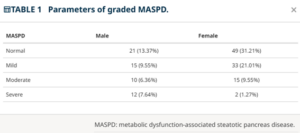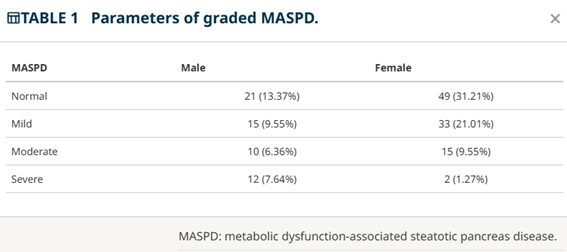HIGHLIGHTS
- Metabolic dysfunction-associated steatotic pancreas disease (MASPD) is a recent discovery in the world of metabolic disorders, and its potential connection to insulin resistance (IR) has sparked significant interest.
- Pancreatic steatosis, a defining characteristic of MASPD, may disrupt the delicate balance of the pancreas, potentially hindering its ability to secrete insulin effectively.
- The relationship between MASPD and IR is increasingly important for understanding the pathophysiology of both conditions and may have clinical implications in their prevention and management.
- Research suggests a two-way street between MASPD and IR.
ABSTRACT – Background –
To investigate the association between metabolic dysfunction-associated steatotic pancreas disease (MASPD) and insulin resistance (IR).
Methods: This cross-sectional study involved 157 participants diagnosed with MASPD based on ultrasonography criteria. Baseline demographic data were collected, including age, gender, and body mass index. Serum levels of fasting glucose, insulin, lipid profile (including total cholesterol, triglycerides, high-density lipoprotein cholesterol, and low-density lipoprotein cholesterol), glycated hemoglobin and insulin were measured using standardized laboratory techniques. Abdominal ultrasonography was performed on all participants using convex transducer (frequency range, 3,5 MHz) by experienced radiologist blinded to the clinical data. The association between MASPD and IR was assessed using logistic regression analysis, adjusting for potential confounders. Statistical significance was set at a P-value <0.05.
Results: The logistic regression analysis was performed to verify whether MASPD was a risk factor for IR. After adjusting for gender and age, the results show a significant correlation between MASPD and markers of IR. TyG index: OR (95%IC) 5.72 (1.90-16.00), P 0.021, and HOMA -IR: OR (95%IC) 6.20 (2.1-22.00) P 0.037.
Conclusion: This study presents a description of MASPD and its association with IR indices. Our findings show a significant correlation between MASPD and markers of IR. These results suggest that MASPD may contribute to the development of insulin resistance and further highlight the importance of pancreatic health in metabolic disorders.
AUTORES
ANDRADE, Luís Jesuino de Oliveira OLIVEIRA, Gabriela Correia Matos de BITTENCOURT, Alcina Maria Vinhaes BAPTISTA, Gustavo Magno SILVA, Catharina Peixoto OLIVEIRA, Luís Matos de



